The cyber security threat in six charts
What happens when UK firms experience security attacks?


The threat of cyber security is unquestionably growing more serious over time. The impact of attacks on businesses can be devastating, and for many, the source remains unknown - as many as 35% of attacks on UK-based organisations are from an unknown source.
The majority of organisations consider dealing with cyber threats, and ransomware in particular, as a high priority, but many lack confidence in their ability to respond to a successful attack.
These charts are from two reports by Malwarebytes. The first is a report into Cybercrime tactics and techniques: 2017 state of malware', evaluating the key findings and cybercrime trends in 2017. The second is a survey on 'The Second Annual State of Ransomware' undertaken in the United Kingdom as part of a larger survey of organisations across the world on ransomware and other critical security issues. It was conducted with small to mid-sized businesses during June 2017, with individuals who are responsible for or knowledgeable about cyber security issues at 175 UK organisations.
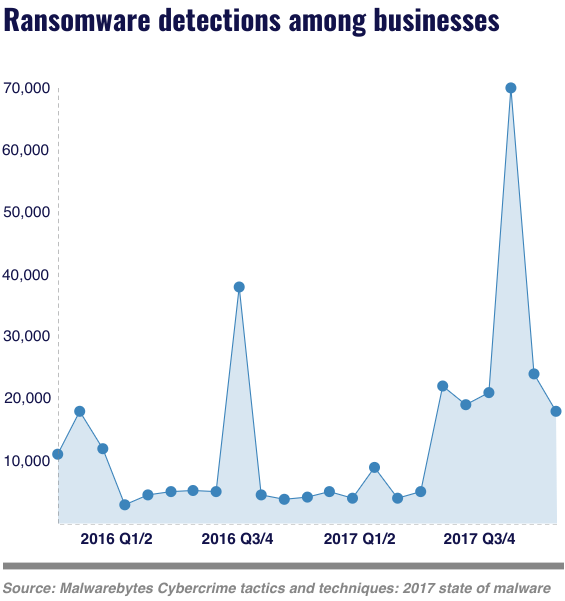
Ransomware attacks saw a serious spike in Q3 of 2017
Statistically, 2017 was a banner year for ransomware. According to the report, business and consumer ransomware detections have increased 90% and 93% respectively, largely because of families like WannCry, Locky, Cerber and Globelmposter. In fact, the monthly rate of ransomware attacks against businesses increased up to 10 times the rate of 2016.
The summer months brought in a flood of ransomware infections from a couple of new players. Between July and September 2017, there was a 700% increase in ransomware, with Globelmposter and WannaCry making up most of that statistic.
In addition, nearly seven percent of all attacks against businesses in September 2017 involved ransomware, compared to the average rate of ransomware attacks in 2016, which totalled 1.11%
Get the ITPro daily newsletter
Sign up today and you will receive a free copy of our Future Focus 2025 report - the leading guidance on AI, cybersecurity and other IT challenges as per 700+ senior executives
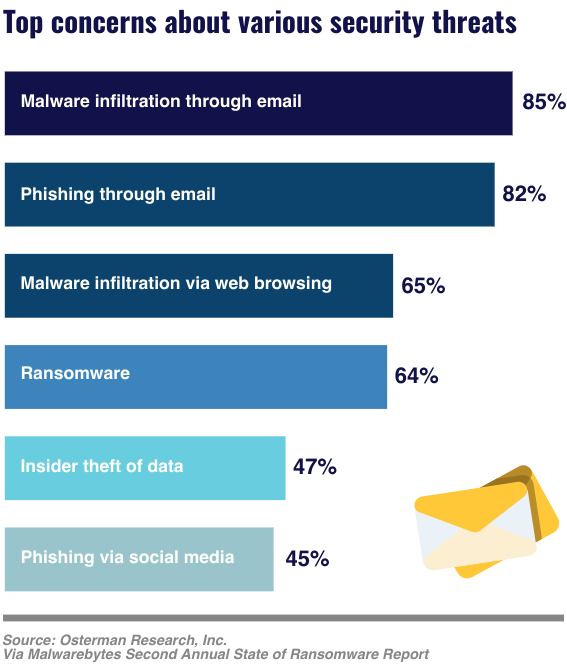
Malware infiltration through email is the top security concern
For 85% of organisations, the top concern is malware infiltration through email, closely followed by phishing through email. For both of these attacks, email servers only form part of the defence, and businesses are reliant on staff being able to identify suspicious emails.
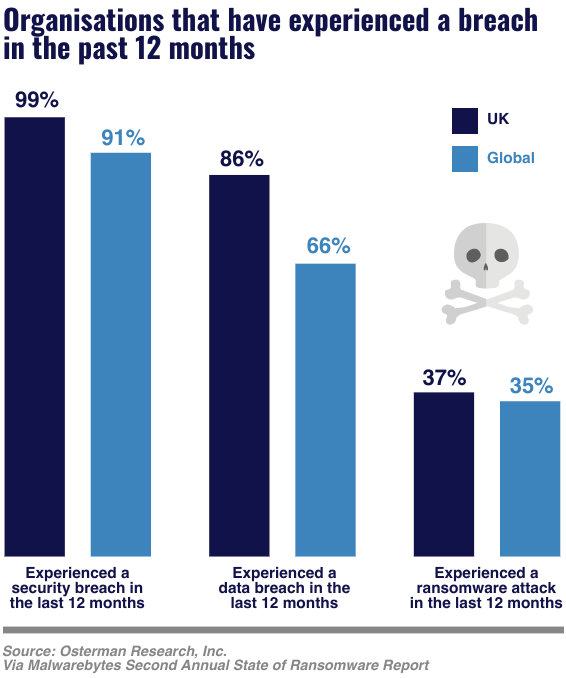
Almost all UK organisations have experienced security attacks
Most organisations in the UK have experienced various types of security attacks and data breaches over the past year, with many facing some type of security-related incident on a more than monthly basis. But with 44% of decision-makers being fairly or very confident that they can stop attacks, it looks like the defences are holding for now.
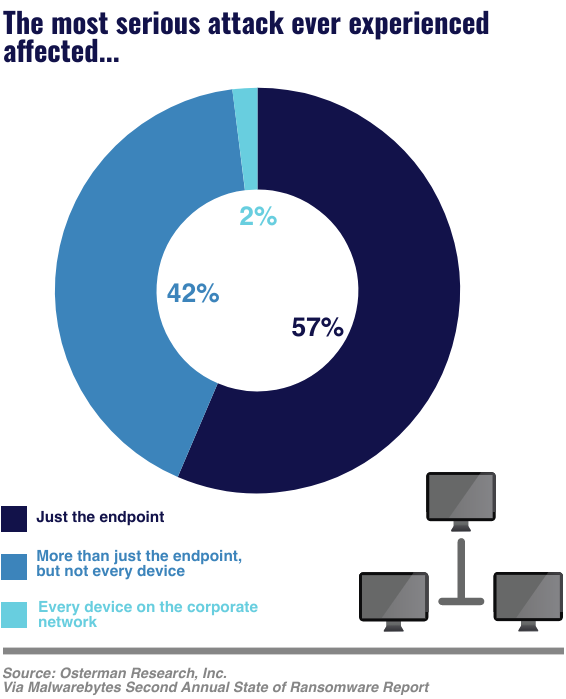
Most ransomware incidents have affected just the endpoint
Of the most serious ransomware attacks that have hit organisations, 57% have affected just an organisation's endpoint. However, for 2% of companies, the impact of ransomware has been devastating, affecting every device on the corporate network.
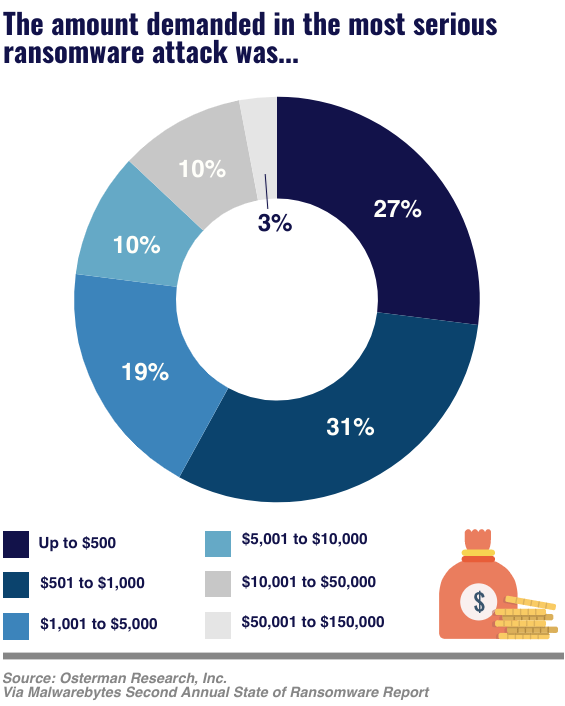
Ransom demands from cyber criminals are fairly small
Over half of ransom demands from cyber criminals to small and mid-sized businesses are for less than $1,000. However, there are still a fair proportion of criminals who ask for much larger sums, with 42% asking for more than $1,000 and 3% demanding a whopping $50,000 to $150,000 to release files. Survey respondents reported that more than two in five UK organisations opted to pay the ransom demand in the most serious ransomware attack.
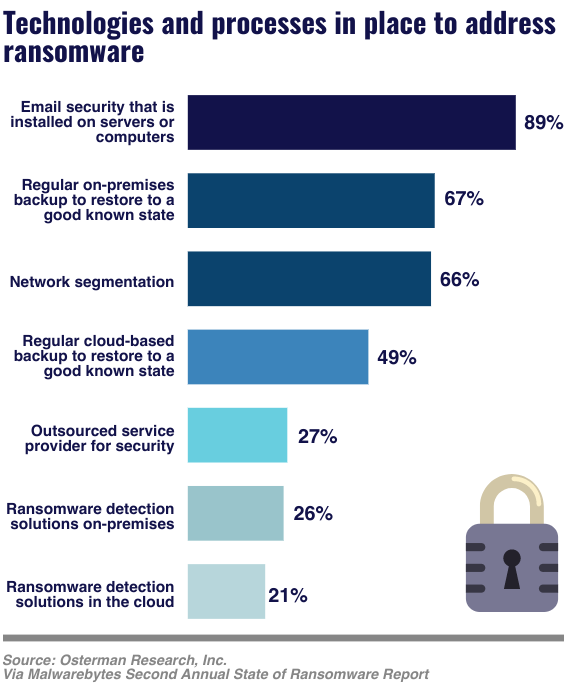
Email security is the top process in place to address cyber attacks
Most of the surveyed organisations in the UK have deployed email security to address malware and phishing attempts. They have also implemented regular, on-premises data backups so that they can restore affected machines to a known good state as quickly as possible. Many organisations have also implemented network segmentation, used outsourced security providers, on-premises ransomware-detection solutions, and regular cloud-based backup capabilities to further counter threats.
Esther is a freelance media analyst, podcaster, and one-third of Media Voices. She has previously worked as a content marketing lead for Dennis Publishing and the Media Briefing. She writes frequently on topics such as subscriptions and tech developments for industry sites such as Digital Content Next and What’s New in Publishing. She is co-founder of the Publisher Podcast Awards and Publisher Podcast Summit; the first conference and awards dedicated to celebrating and elevating publisher podcasts.
-
 Bigger salaries, more burnout: Is the CISO role in crisis?
Bigger salaries, more burnout: Is the CISO role in crisis?In-depth CISOs are more stressed than ever before – but why is this and what can be done?
By Kate O'Flaherty Published
-
 Cheap cyber crime kits can be bought on the dark web for less than $25
Cheap cyber crime kits can be bought on the dark web for less than $25News Research from NordVPN shows phishing kits are now widely available on the dark web and via messaging apps like Telegram, and are often selling for less than $25.
By Emma Woollacott Published
-
 ‘Phishing kits are a force multiplier': Cheap cyber crime kits can be bought on the dark web for less than $25 – and experts warn it’s lowering the barrier of entry for amateur hackers
‘Phishing kits are a force multiplier': Cheap cyber crime kits can be bought on the dark web for less than $25 – and experts warn it’s lowering the barrier of entry for amateur hackersNews Research from NordVPN shows phishing kits are now widely available on the dark web and via messaging apps like Telegram, and are often selling for less than $25.
By Emma Woollacott Published
-
 Healthcare systems are rife with exploits — and ransomware gangs have noticed
Healthcare systems are rife with exploits — and ransomware gangs have noticedNews Nearly nine-in-ten healthcare organizations have medical devices that are vulnerable to exploits, and ransomware groups are taking notice.
By Nicole Kobie Published
-
 Alleged LockBit developer extradited to the US
Alleged LockBit developer extradited to the USNews A Russian-Israeli man has been extradited to the US amid accusations of being a key LockBit ransomware developer.
By Emma Woollacott Published
-
 February was the worst month on record for ransomware attacks – and one threat group had a field day
February was the worst month on record for ransomware attacks – and one threat group had a field dayNews February 2025 was the worst month on record for the number of ransomware attacks, according to new research from Bitdefender.
By Emma Woollacott Published
-
 CISA issues warning over Medusa ransomware after 300 victims from critical sectors impacted
CISA issues warning over Medusa ransomware after 300 victims from critical sectors impactedNews The Medusa ransomware as a Service operation compromised twice as many organizations at the start of 2025 compared to 2024
By Solomon Klappholz Published
-
 Warning issued over prolific 'Ghost' ransomware group
Warning issued over prolific 'Ghost' ransomware groupNews The Ghost ransomware group is known to act fast and exploit vulnerabilities in public-facing appliances
By Solomon Klappholz Published
-
 The Zservers takedown is another big win for law enforcement
The Zservers takedown is another big win for law enforcementNews LockBit has been dealt another blow by law enforcement after Dutch police took 127 of its servers offline
By Solomon Klappholz Published
-
 There’s a new ransomware player on the scene: the ‘BlackLock’ group has become one of the most prolific operators in the cyber crime industry – and researchers warn it’s only going to get worse for potential victims
There’s a new ransomware player on the scene: the ‘BlackLock’ group has become one of the most prolific operators in the cyber crime industry – and researchers warn it’s only going to get worse for potential victimsNews Security experts have warned the BlackLock group could become the most active ransomware operator in 2025
By Solomon Klappholz Published